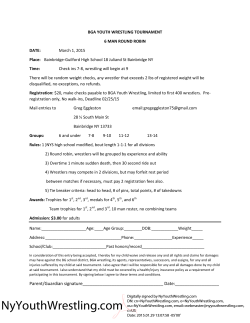
Resistance Training Based on Analysis of
Resistance Training Based on Analysis of Wrestling Techniques Bahman Mirzaei (University of Guilan, Rasht, Iran) Ioannis Barbas (DUTH, Greece) David Curby (USA wrestling, USA) Behnam Naghipour Givi (Allame tabatabaei Uni, Tehran, Iran) Mohammad H. Ghahramani (Ferdowsi Uni of Mashhad, Iran) Summary Physical preparation is one of the most components affecting wrestlers’ performance and strength training will obviously play a significant role in a wrestler's overall training plan. Most wrestlers and their coaches understand the necessity for strength training. This type of training can enhance wrestlers’ characteristics. But the main question is: “How resistance training can be simulated with performing actual wrestling techniques?” However, if the focus is only on increasing absolute strength and muscular size, the benefits of resistance training are severely restricted. Wrestlers must react with power to opponent's attack and maintain that power over numerous rounds. Simply lifting weights is not the best approach to do this. So, according to the principle of specificity of training, a strength training program should be concentrated on exercises that use the wrestling muscles. In fact, only those muscles that are trained will adapt and change in response to a resistance training program. In addition, based on SAID principle, Specific Adaptations to Imposed Demands relate to the fact that the adaptation will be specific to the characteristics of the workout used. Overall, the best weight training exercises for wrestlers are compound, multi-joint movements like squats, presses, and rows/pulls that mimic how wrestlers actually perform on the mat. In this article we focused on step-by-step process of developing a wrestling specific strength training plan that meets the demanding nature of wrestling: 1. Determination of the wrestler’s weakness in a certain technique (hip toss etc.) 2. Analysis of a certain technique to its components according to the principles of kinesiology (flexion, extension, abduction…) 3. Determination of the muscle or the groups of muscles which predominantly involved in the movements 4. Simulation of resistance training with actual condition of performing wrestling techniques. Here is an example: Fig (1). Steps of “hip toss”. Table 1. Muscles that predominantly involved in the “hip toss” Movement Muscles Accessory muscles Elbow flexion Biceps brachii Anterior brachii Brachioradialis ****** No 1 2 Leg internal rotation Gluteus minimus & medius tensor-fasciae-latae 3 Knee extension Quadriceps ****** 4 Trunk flexion Rectus abdominus Internal oblique External oblique Movement Muscles Accessory muscles No 1 ****** Elbow flexion 2 Leg internal rotation 3 Knee extension 4 Trunk flexion ****** Fig (2). Simulations of “hip toss” with elastic band and free weights. Core, lower body, and upper body strength are all vital components of a wrestler’s weight training routine. References: - Mirzaei, B., Naghipour, B., Ghahramani, M.S., 2012. Resistance training based on analysis of wrestling techniques. SSRC publication (Persian). Mirzaei, B., 2010. Science of training in wrestling, Beh Nashr publication (Persian). Lee E. Brown, 2007. Strength training, National Strength and Conditioning Association (NSCA), Human kinetics. Kraemer, W.J., and N.A. Ratamess. 2004. Fundamentals of resistance training: Progression and exercise prescription. Medicine and Science in Sports and Exercise 36(4):674-688.
© Copyright 2025













